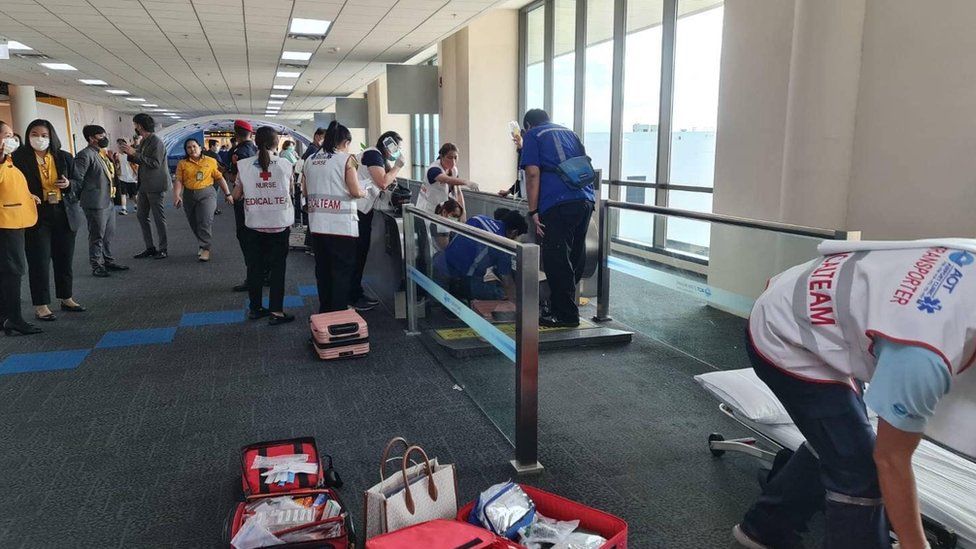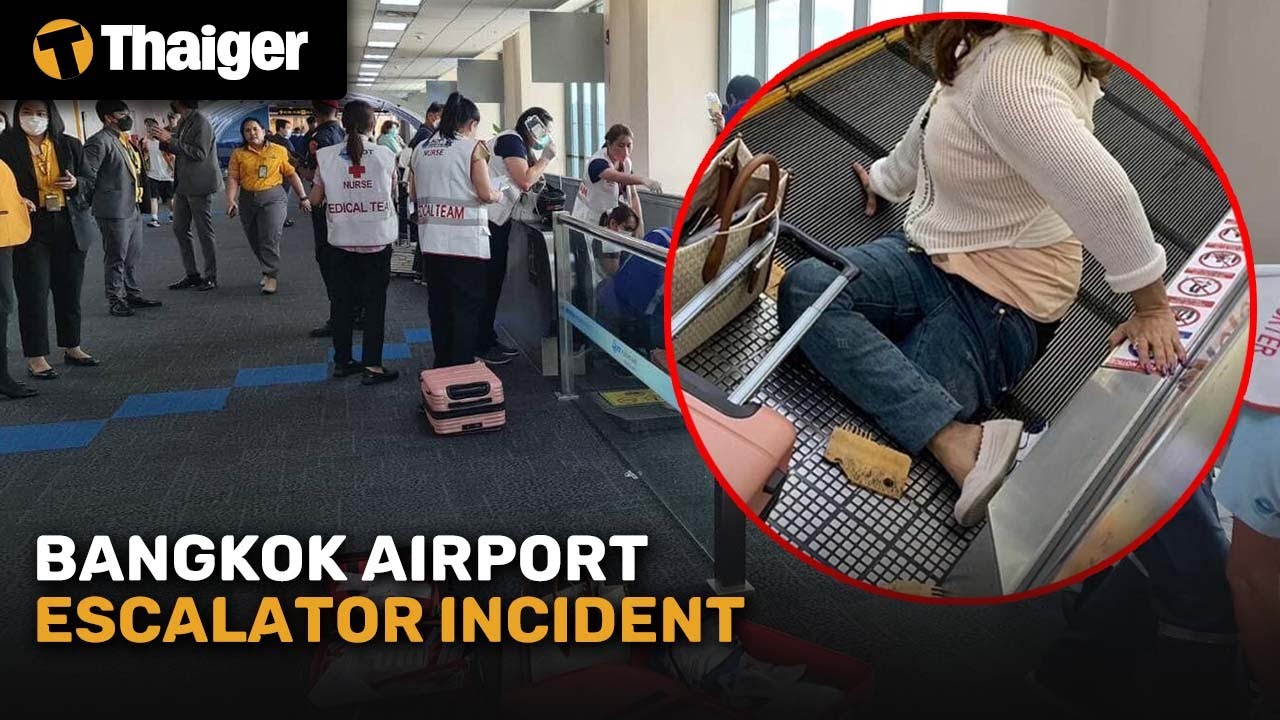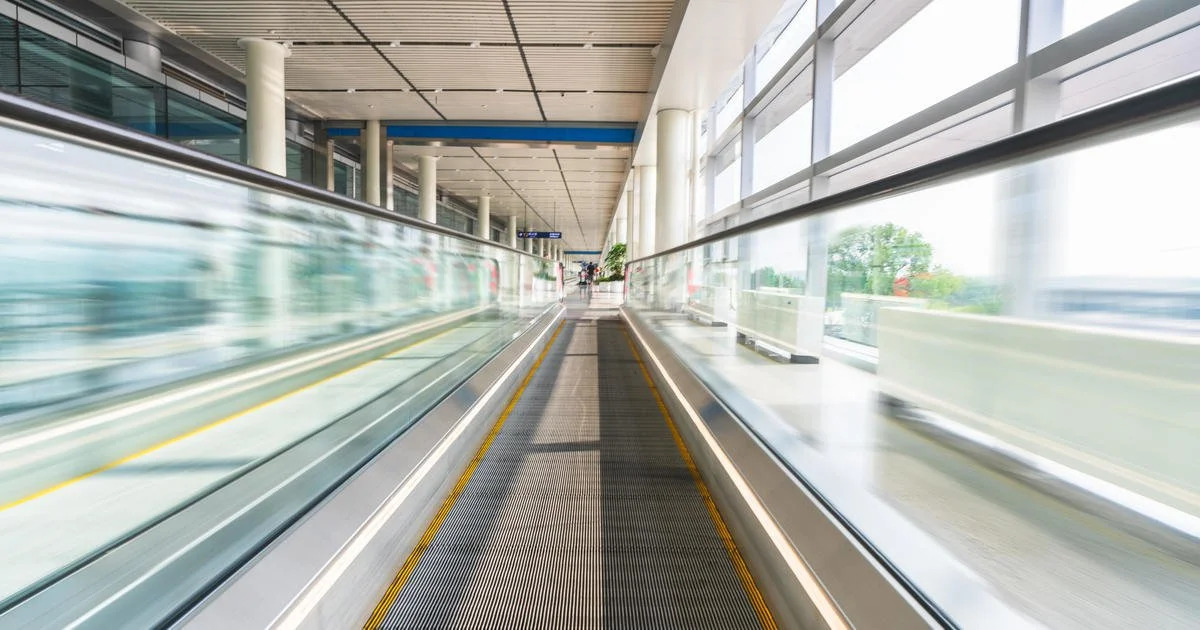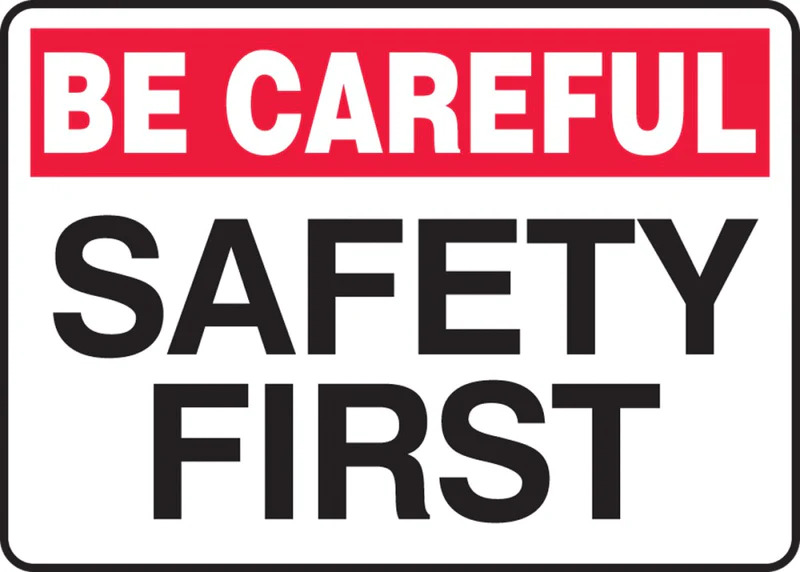Woman Trapped In Travelator Rescued With Leg Amputation In Thailand
A woman traveling through Bangkok's Don Mueang airport experienced a horrifying accident when her leg became trapped in a travelator. The woman trapped in travelator rescued with leg amputation in Thailand on Thursday morning has left her family in shock and raised concerns about the woman's mental well-being.
Author:Black Crystal Reviewer:Maxwell CanvasJul 03, 202327.8K Shares397.9K Views

A woman traveling through Bangkok's Don Mueang airport experienced a horrifying accident when her leg became trapped in a travelator. The woman trapped in travelator rescued with leg amputation in Thailandon Thursday morning has left her family in shock and raised concerns about the woman's mental well-being.
The airport management expressed deep sadness and pledged to compensate the victim for her loss and cover her medical expenses. As investigations into the incident are underway, questions are being raised about the safety of the travelators and the need for their timely replacement.
Woman Trapped In Travelator Rescued With Leg Amputation In Thailand At Bangkok Airport
The woman, whose identity has not been disclosed, was en route to board a flight when she tripped over her suitcase, causing her leg to become lodged in the travelator. The accident unfolded in Terminal 2 of Bangkok's Don Mueang Airport, causing distress among witnesses and passersby who desperately tried to halt the machine and free the victim. Unfortunately, their efforts were in vain as the travelator continued to tear through the woman's leg, resulting in severe damage to her muscles, tendons, and bones.
Shock And Concern For The Victim's Well-Being
The victim's son took to social media to express his family's shock and concern for his mother's mental health after the amputation. He described her as initially showing strength through her facial expression and tone of voice but acknowledged that deep down, she was shattered by the sudden loss of her leg.
In a heartfelt post, he acknowledged that their lives would never be the same and expressed the family's inability to restore her leg or the life she had known.

Thailand News | Thai woman loses leg on Bangkok airport escalator
Airport's Response And Investigation
Airport management expressed their deep sadness over the incident and assured the victim that they would take full responsibility for her medical expenses and provide compensation for the partial loss of her leg.
The airport director announced that an investigation is underway to determine the cause of the accident.
While the specific travelator involved had been in operation since 1996, the airport had already planned to replace several old travelators by 2025. The incident may prompt the acceleration of this process, prioritizing passenger safety.
Safety Concerns And Similar Incidents Worldwide
The accident in Bangkok highlights the potential dangers posed by travelators and the need for regular maintenance and upgrades to ensure passenger safety. Similar incidents have occurred at airports and other public spaces around the world, causing serious injuries and even fatalities. These incidents emphasize the importance of ongoing vigilance and proper safety protocols in the design, maintenance, and operation of such machines.
In 2019, an airport worker tragically lost their life after being sucked into an engine on the tarmac of San Antonio International Airport. The incident serves as a reminder that safety measures must extend beyond passenger areas to protect the workers who maintain and operate airport facilities.
Urgent Focus On Safety And Upgrades
The recent accident in Bangkok has highlighted the need for airports and other public spaces to prioritize passenger safety by implementing rigorous safety inspections, maintaining clear emergency procedures, and investing in the timely replacement of outdated equipment. The incident has prompted Don Mueang Airport authorities to evaluate their existing travelators and expedite the process of upgrading to newer models.
As technology advances, newer travelators with improved safety features are becoming available. These advancements include better mechanisms to detect obstacles, emergency stop functions, and enhanced durability. Public spaces must take advantage of these advancements to ensure the well-being of passengers and prevent accidents like the one witnessed in Bangkok.
Safety Measures For Escalators And Travelators
Escalators and travelators provide a convenient means of transportation, but it is crucial to prioritize safety when using them. Proper maintenance and adherence to safety guidelines ensure a secure environment for users.
Here are some essential safety measures and standard safety features that should be implemented.
Safety Precautions For Escalators And Travelators
Ensure the safety of escalator and travelator users by implementing necessary precautions and safety measures.
- Wedge Guards and Partition Plates- Install wedge guards beneath the floor ceiling at the point where escalators or travelators intersect to prevent anything from catching in the wedges. If there is an opening between the escalators or travelators and the building floor, use partition plates or guards to prevent falls.
- Safety Nets- If there is a gap of 200mm or more between escalators or travelators or between them and the floor opening, provide safety nets to prevent accidents.
- Warning Signage and Notices- Display warning signs and notices or use public announcement equipment to prohibit children from playing around the escalators, ensuring their safety.
- Preventive Maintenance and Inspection- Regular preventive maintenance and inspections are crucial for keeping escalators and travelators in safe working condition. This includes checking for any potential issues and addressing them promptly.
Standard Safety Features
Discoverthe standard safety features that should be incorporated into escalators and travelators to enhance user safety and prevent accidents.
- Motor Overload Protection- In case of motor overload or overheating, the power supply to the motor is automatically disconnected to prevent damage.
- Phase Failure Protection- The power supply to the drivingmachine is disconnected if there is a phase failure or phase reversal.
- Non-Reversal Safety Devices- Stops the escalator if it operates reversely from the pre-set direction.
- Emergency Stop Button- Pressing the emergency stop button immediately halts the escalator during emergencies.
- Electromagnetic Braking Device- This enables the motor to stop smoothly through spring force action if a power failure occurs or any safety device is activated.
- Drive Chain Safety Device- Stops the escalator if the drive chain elongates excessively or breaks.
- Step Sagging Safety Device- Activates to halt the escalator if the steps or step rollers sag more than 3mm.
- Skirt Guard Safety Device- Stops the escalator if a foreign object becomes caught between the skirt guard and steps.
- Broken Step Chain Safety Device- Halts the escalator if the step chain stretches excessively or breaks.
- Comb Plate Safety Device- Activates if a foreign object gets caught between the comb plates, immediately switching off the escalators or travelators.
- Step/Pallet Chain Safety Device- Monitors the step or pallet chain and stops the escalator if any issues are detected.
- Handrail Entry Safety Device- If an object becomes wedged in the handrail entry points, a contact is actuated, leading to the escalator being switched off.
- Demarcation Line- Clearly marks the edges between adjacent steps and between the step and skirt guard, preventing passengers from stepping on these areas.
Optional Safety Features
Explore additional safety features that can be installed in escalators and travelators to provide an extra layer of protection for users.
- Auxiliary Brake- Actuated when the drive chain breaks or there is an overspeed condition.
- Handrail Speed Monitor- Detects if one or both handrails break or run at an abnormal speed, triggering safety protocols.
- Missing Step/Pallet Device- Halts the escalator if a step is missing, preventing further movement toward the comb plate.
- Step Upthrust Contact- Stops the escalator in case of a step Upthrust situation.
- Skirting Brush- Covers the gap between the step and skirt panel, minimizing any potential risks associated with the gap.
- Under-Step Lighting - Illuminates individual steps or pallets, ensuring clear visibility and distinction.
- Step Obstruction Device - Stops the escalator if any obstruction is detected along its path of descent.
- Comb Lighting - Highlights the start and finish of the moving steps or pallets for improved visibility.
- Automatic Announcement System -Provides automatic announcements or warnings to passengers, enhancing communication and safety awareness.
Implementing these safety measures and features, along with regular maintenance and inspections, is essential to ensure the utmost safety of escalators and travelators. By prioritizing safety, we can create a secure environment for users and prevent accidents in these public spaces.
Tips For Safely Riding Escalators And Travelators
Embarking on a smooth and secure journey is essential when utilizing escalators and moving walkways. These convenient transportation options are commonly found in airports, shopping malls, and various public spaces.
To ensure your safety and the safety of others, it's important to follow these guidelines while riding escalators and moving walkways.
Entering Safely
Learn important tips and precautions for safely entering escalators and travelators to ensure a smooth and secure boarding experience.
- Leave wheeled items behind -Do not ride escalators or moving walkways with canes, walkers, carts, strollers, or any other wheeled vehicles. These objects can cause imbalance or become stuck, posing risks to both you and others.
- Proper footwear is crucial -Ensure that you are wearing appropriate footwear, securely tied to prevent accidents. Avoid riding barefoot or with loose shoelaces that could become entangled in the mechanism.
- Check the direction -Before boarding an escalator, observe the direction in which the steps are moving. Only enter when the steps are going in the right direction.
- Exercise caution when stepping on and off -Take your time when stepping onto and off of escalators and moving walkways, particularly if you wear bifocals. Ensure a firm footing before proceeding.
- Ensure children's safety -If accompanied by children, hold their hand firmly to prevent them from losing balance or getting too close to the sides.
- Secure packages -If carrying small packages, hold them securely in one hand to maintain balance and prevent them from falling.
- Grasp the handrail -As you step onto the moving escalator or walkway, hold onto the handrail firmly for stability.
- Avoid touching the sides -Refrain from touching the sides below the handrail, as they may pose risks or cause injury.
- Mind loose clothing -Ensure that loose clothing, such as long skirts or wide scarves, is clear of the steps and sides to prevent entanglement.
- Consider alternatives if uncomfortable -If you feel uncomfortable boarding or riding escalators or moving walkways, choose elevators instead. Your safety should always be a priority.
Riding Safely
Discover essential guidelines and safety measures to follow while riding escalators and travelators, ensuring a safe and comfortable journey.
- Position yourself correctly -When riding escalators, stand in the center of the step, facing forward. On moving walkways, stay to the right if you are stationary and allow those who wish to walk to pass on the left.
- Keep feet clear -Maintain a safe distance from the sides of the escalator or moving walkway to avoid accidental contact or tripping hazards.
- Hold onto the handrail -Maintain a steady grip on the handrail to ensure balance throughout the ride. Avoid placing handbags or parcels on the handrail to prevent obstructions.
- Stay alert -Pay attention to the movement of the escalator or moving walkway, remaining aware of your surroundings without being distracted.
- Avoid leaning or overreaching -Refrain from leaning against or over the sides of the escalator or moving walkway. Keep an upright posture and stay within the designated boundaries.
- Avoid running -Maintain a calm and controlled pace while riding escalators or moving walkways. Running poses risks to yourself and others.
- Do not sit -Sitting on escalator steps or the moving walkway is not permitted. These areas are designed for standing or walking, and sitting can disrupt the flow of passengers and cause accidents.
- Ensure children's proper behavior -Parents or guardians should ensure that children ride escalators and move walkways safely and responsibly, following all the guidelines mentioned.
Exiting Safely
Explore key tips and precautions to ensure a safe and efficient exit from escalators and travelators, promoting a seamless transition to your destination.
- Step off promptly -Once you reach your destination, step off the escalator or moving walkway promptly.
- Maintain a steady flow -Avoid hesitating or stopping abruptly. Move clear of the exit area without delay to allow other passengers to exit smoothly behind you.
By adhering to these safety guidelines, you can contribute to a secure and pleasant experience for yourself and fellow riders when using escalators and moving walkways. Prioritize safety at all times, remaining mindful of others to ensure a smooth and accident-free journey.
People Also Ask
What Is The Purpose Of Travelator?
A travelator, also referred to as a moving walkway, is a horizontal conveyor system designed for transporting people over short to medium distances. It finds its application in various commercial and public settings like airports, train stations, and shopping centers.
What Is The Difference Between An Escalator And A Travelator?
While escalators are widely recognized as the most efficient way to transport large volumes of people between floors, "travelators" are referred to as "moving walkways" or "a moving sidewalk" or "autowalks" in the United States.
What Are The Components Of A Travelator?
A travelator consists of essential components including a frame composed of a stationary part and a moving part, a drive wheel mounted on a bearing for rotation, and a power unit responsible for rotating the drive wheel.
Conclusion
In conclusion, the incident of a woman trapped in travelator rescued with leg amputation in Thailand serves as a stark reminder of the importance of prioritizing safety in public spaces.
It highlights the need for thorough maintenance, regular inspections, and the implementation of advanced safety features in escalators and travelators to prevent such unfortunate accidents. Ensuring the well-being of passengers should always be a top priority, and proactive measures must be taken to create secure environments for all travelers.
Jump to
Woman Trapped In Travelator Rescued With Leg Amputation In Thailand At Bangkok Airport
Shock And Concern For The Victim's Well-Being
Airport's Response And Investigation
Safety Concerns And Similar Incidents Worldwide
Urgent Focus On Safety And Upgrades
Safety Measures For Escalators And Travelators
Tips For Safely Riding Escalators And Travelators
People Also Ask
Conclusion

Black Crystal
Author
Black Crystal is a captivating writer who finds inspiration in the quiet corners of the street and the mysterious depths beneath bridges. With a penchant for the night, she crafts enchanting tales that explore the uncharted realms of the human experience. Embracing the darkness as her muse, Black Crystal's evocative prose and haunting imagery transport readers into a world where secrets whisper and dreams take shape.
Her writing defies categorization, inviting readers to uncover the magic hidden within the shadows and embrace the enigmatic beauty of her nocturnal narratives. Step into her realm, where the written word dances with ethereal grace, and immerse yourself in the captivating stories she weaves.

Maxwell Canvas
Reviewer
Maxwell Canvas, a charismatic and fearless crypto evangelist, defies conventions and blazes a trail in the realm of digital currencies. With his unique physique serving as a symbol of resilience, he challenges societal norms and proves that true expertise transcends appearances. Against a backdrop of a blurred and ever-shifting market, Maxwell's work becomes a masterpiece, painting a vivid picture of knowledge and inspiration.
With unwavering passion, Maxwell empowers others to embrace the transformative potential of blockchain technology. His captivating presence and unyielding dedication captivate audiences, turning skepticism into curiosity and igniting a spark of interest in the world of cryptocurrencies. Maxwell Canvas stands as a visionary force, leaving an indelible mark on the crypto landscape, inspiring others to explore decentralized possibilities and embrace a future of innovation and financial empowerment.
Latest Articles
Popular Articles


